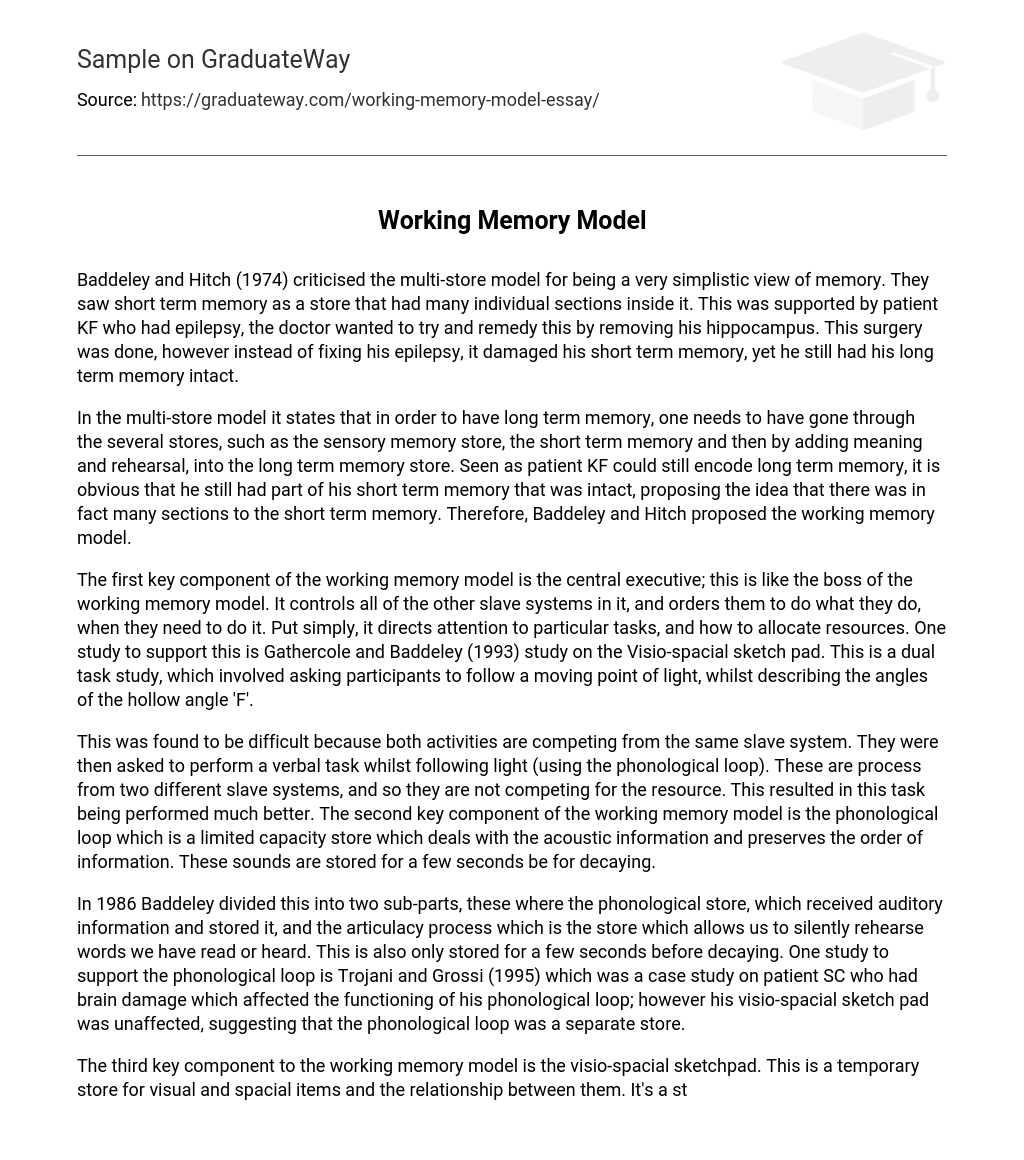Baddeley and Hitch (1974) criticised the multi-store model for being a very simplistic view of memory. They saw short term memory as a store that had many individual sections inside it. This was supported by patient KF who had epilepsy, the doctor wanted to try and remedy this by removing his hippocampus. This surgery was done, however instead of fixing his epilepsy, it damaged his short term memory, yet he still had his long term memory intact.
In the multi-store model it states that in order to have long term memory, one needs to have gone through the several stores, such as the sensory memory store, the short term memory and then by adding meaning and rehearsal, into the long term memory store. Seen as patient KF could still encode long term memory, it is obvious that he still had part of his short term memory that was intact, proposing the idea that there was in fact many sections to the short term memory. Therefore, Baddeley and Hitch proposed the working memory model.
The first key component of the working memory model is the central executive; this is like the boss of the working memory model. It controls all of the other slave systems in it, and orders them to do what they do, when they need to do it. Put simply, it directs attention to particular tasks, and how to allocate resources. One study to support this is Gathercole and Baddeley (1993) study on the Visio-spacial sketch pad. This is a dual task study, which involved asking participants to follow a moving point of light, whilst describing the angles of the hollow angle ‘F’.
This was found to be difficult because both activities are competing from the same slave system. They were then asked to perform a verbal task whilst following light (using the phonological loop). These are process from two different slave systems, and so they are not competing for the resource. This resulted in this task being performed much better. The second key component of the working memory model is the phonological loop which is a limited capacity store which deals with the acoustic information and preserves the order of information. These sounds are stored for a few seconds be for decaying.
In 1986 Baddeley divided this into two sub-parts, these where the phonological store, which received auditory information and stored it, and the articulacy process which is the store which allows us to silently rehearse words we have read or heard. This is also only stored for a few seconds before decaying. One study to support the phonological loop is Trojani and Grossi (1995) which was a case study on patient SC who had brain damage which affected the functioning of his phonological loop; however his visio-spacial sketch pad was unaffected, suggesting that the phonological loop was a separate store.
The third key component to the working memory model is the visio-spacial sketchpad. This is a temporary store for visual and spacial items and the relationship between them. It’s a store for what items look like and where they are located. It helps us navigate and interact with the physical environment. It also helps us to understand where we are in relation to other objects and store information on the form and colour of it. This information is then rehearsed through mental pictures; however it has a limited capacity.
One study that shows the Visio-spacial sketchpad is a separate store is the Gathercole and Baddeley (1993) study, as mentioned above. In 2000, Baddeley added another slave system called the episodic buffer. This is because he realised the model needed a general store to operate properly. As the central executive, phonological and visual-spacial all have a limited capacity there needed to be a store that linked them all too together. To put simply, it integrated all of the other stores together into one unitary code, in order to remember a movie scene.
One study to support this is Baddeley et al (1987)… The working memory model has strength over the multi-store model as it provides with a more in depth analysis of short term memory than the multi store model. It also helps to explain why individuals may be better at some short term memory tasks, but not others. Another positive is the fact that it can be applied, or rather generalised to real life. For example in job interviews when we talk, or when people text and drive, and it can cause us to crash.
Finally another strength of the working memory model is that is provides us an explanation for the brain damaged patients KF and SC. As it shows us logical evidence that there is other stores in memory, rather than the oversimplified view of the multi-store model. However, it does have its weakness, one such weakness is its only address short term memory, not long term memory, and therefore it is not a detailed model of memory, as it doesn’t address long term memory. Another weakness is the circular argument, as it makes it difficult to find fault with the working memory mode.
The circular argument is that if two task cannot be done together, then it’s assumed that tis is because both of which are overloading on of the components in the working model. If two tasks can be done together, it’s assumed they are from different components of the working model, meaning the model can explain any results. Finally another weakness is the fact that the working memory model has been conducted in laboratories. Therefore it means that it may not be able to generalise these result into everyday life.





